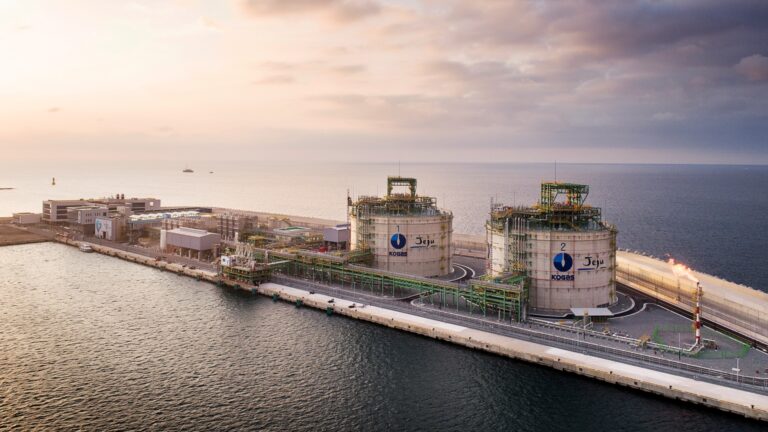A new report by the Institute for Energy Economics and Financial Analysis (IEEFA) has found that South Korea is rapidly developing liquefied natural gas (LNG) import and storage terminals, presenting a high risk of overinvestment and overcapacity.
 Illustration; Archive; Courtesy of KOGAS
Illustration; Archive; Courtesy of KOGAS
According to IEEFA estimates, the country’s LNG industry is pouring ₩11.3 trillion ($8.7 billion) into an infrastructure build-out that has projects at the construction or planning stage to boost receiving capacity for the fossil fuel. Specifically, overall, incumbents and new entrants in the country’s LNG market aim to complete 11 LNG terminal projects by 2031.
“Our analysis demonstrates a growing mismatch between LNG import infrastructure and projected LNG demand based on the country’s net-zero goal,” Michelle Chaewon Kim, the report author and an Energy Finance Specialist, South Korea, at IEEFA, stated.
The report identified reasons why state-owned and private-sector firms are overly developing LNG import infrastructure, and the issues worsening the overinvestment risks. Moreover, it suggested how the South Korean government and companies can mitigate those risks, IEEFA said.
Ongoing conflicts in the world could keep South Korean gas prices elevated, Kim claimed, noting: “This could decrease imports by LNG receiving terminals operated or leased by independent power producers, adding to underutilization and stranded asset risks.”
“We believe that a faster transition to renewable energy will mitigate the highly volatile fossil fuel cost of power generation caused by unforeseen supply shocks and bolster the energy security of South Korea.”
 Courtesy of IEEFA, MOTIE
Courtesy of IEEFA, MOTIE
Kim further noted: “We believe that the underutilization of LNG receiving terminals will likely worsen if South Korea further revises its ‘Nationally Determined Contribution’ target to reduce the share of LNG-fired power generation in the energy mix in the coming years.”
As of 2023, South Korea has seven LNG import terminals with a combined regasification capacity of around 153 million tons per annum (mtpa), along with 6.3 million tons of LNG storage capacity, IEEFA said, pointing out that its projections show that unused LNG regasification capacity could rise from 107.9 mtpa this year to 152.8 mtpa in 2036, dampening the already muted utilization rate of 29.5% to 19.8%.
In regard to the storage capacity of the proposed projects, IEEFA claimed that if completed, it would meet 25.6% of annual LNG demand in 2036. This is nearly double the 14.1% presently.
Kim remarked: “In practical terms, the planned storage capacity could store around 93 days’ worth of annual LNG demand in 2036, up from the current 52 days. This figure well surpasses the government’s mandated target of nine days of peak winter demand.”
Kim further said that competition is causing developers to propose large LNG infrastructure projects in close proximity to one another, which will pose a challenge in securing end-users for the terminals.
Smaller companies are spurring regasification and storage tank investment to secure a larger market share and reduce dependence on state utility Korea Gas Corporation (KOGAS), IEEFA claimed, noting that these firms will all likely end up jostling for the limited number of terminal users, highlighting a need for better public-private coordination.
According to the report, “the industry feels that repurposing and retrofitting its existing LNG import infrastructure can help mitigate the risk of stranded assets, such as by producing blue hydrogen from natural gas and sequestrating greenhouse gases through carbon capture, utilization and storage.” However, the new technologies are “premature and controversial,” Kim said.
Thus, IEEFA recommended avoiding the promotion of technologies and services that would prolong LNG use without helping national climate goals.
IEEFA’s report also warned about a heavier burden on taxpayers due to excessive investment. “Private-sector companies engaging in overinvestment may also exacerbate financial stability concerns by increasing their debt,” IEEFA claimed.
“An overbuild of new gas import infrastructure threatens to further bind the health of the South Korean economy to unpredictable global commodity markets, hindering the country’s energy transition to cheaper, domestically sourced renewable energy,” Kim noted.
Europe’s LNG capacity buildout outpaces demand, IEEFA claims
France’s LNG buildout unnecessary amid falling gas demand, says IEEFA
>>> Read full article>>>
Copyright for syndicated content belongs to the linked Source : OffshoreEnergy – https://www.offshore-energy.biz/ieefa-warns-of-overbuild-of-lng-import-infrastructure-in-south-korea/































